Locus coeruleus-CA1 projections are involved in chronic depressive stress-induced hippocampal vulnerability to transient global ischaemia
- PMID: 31270312
- PMCID: PMC6610150
- DOI: 10.1038/s41467-019-10795-9
Locus coeruleus-CA1 projections are involved in chronic depressive stress-induced hippocampal vulnerability to transient global ischaemia
Abstract
Depression and transient ischaemic attack represent the common psychological and neurological diseases, respectively, and are tightly associated. However, studies of depression-affected ischaemic attack have been limited to epidemiological evidences, and the neural circuits underlying depression-modulated ischaemic injury remain unknown. Here, we find that chronic social defeat stress (CSDS) and chronic footshock stress (CFS) exacerbate CA1 neuron loss and spatial learning/memory impairment after a short transient global ischaemia (TGI) attack in mice. Whole-brain mapping of direct outputs of locus coeruleus (LC)-tyrosine hydroxylase (TH, Th:) positive neurons reveals that LC-CA1 projections are decreased in CSDS or CFS mice. Furthermore, using designer receptors exclusively activated by designer drugs (DREADDs)-based chemogenetic tools, we determine that Th:LC-CA1 circuit is necessary and sufficient for depression-induced aggravated outcomes of TGI. Collectively, we suggest that Th:LC-CA1 pathway plays a crucial role in depression-induced TGI vulnerability and offers a potential intervention for preventing depression-related transient ischaemic attack.
Conflict of interest statement
The authors declare no competing interests.
Figures
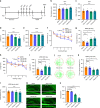
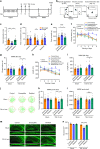
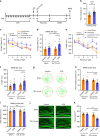
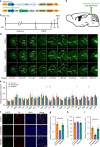


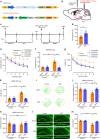
Similar articles
-
Negative Memory Engrams in the Hippocampus Enhance the Susceptibility to Chronic Social Defeat Stress.J Neurosci. 2019 Sep 18;39(38):7576-7590. doi: 10.1523/JNEUROSCI.1958-18.2019. Epub 2019 Aug 12. J Neurosci. 2019. PMID: 31405928 Free PMC article.
-
The locus coeruleus-dorsal hippocampal CA1 pathway is involved in depression-induced perioperative neurocognitive disorders in adult mice.CNS Neurosci Ther. 2024 Feb;30(2):e14406. doi: 10.1111/cns.14406. Epub 2023 Aug 14. CNS Neurosci Ther. 2024. PMID: 37577850 Free PMC article.
-
Stress Accelerates Defensive Responses to Looming in Mice and Involves a Locus Coeruleus-Superior Colliculus Projection.Curr Biol. 2018 Mar 19;28(6):859-871.e5. doi: 10.1016/j.cub.2018.02.005. Epub 2018 Mar 1. Curr Biol. 2018. PMID: 29502952
-
Consequences of tuning network function by tonic and phasic locus coeruleus output and stress: Regulating detection and discrimination of peripheral stimuli.Brain Res. 2019 Apr 15;1709:16-27. doi: 10.1016/j.brainres.2018.06.015. Epub 2018 Jun 13. Brain Res. 2019. PMID: 29908165 Review.
-
Neurochemical and electrophysiological events underlying stress-induced depression in an animal model.Adv Exp Med Biol. 1988;245:425-40. doi: 10.1007/978-1-4899-2064-5_33. Adv Exp Med Biol. 1988. PMID: 2906520 Review.
Cited by
-
Conditional deletion of MAD2B in forebrain neurons enhances hippocampus-dependent learning and memory in mice.Front Cell Neurosci. 2022 Sep 23;16:956029. doi: 10.3389/fncel.2022.956029. eCollection 2022. Front Cell Neurosci. 2022. PMID: 36212696 Free PMC article.
-
Noradrenergic Locus Coeruleus-CA3 Activation Alleviates Neuropathic Pain and Anxiety- and Depression-Like Behaviors by Suppressing Microglial Neuroinflammation in SNI Mice.CNS Neurosci Ther. 2025 Mar;31(3):e70360. doi: 10.1111/cns.70360. CNS Neurosci Ther. 2025. PMID: 40130433 Free PMC article.
-
A molecularly distinct cell type in the midbrain regulates intermale aggression behaviors in mice.Theranostics. 2025 Jan 1;15(2):707-725. doi: 10.7150/thno.101658. eCollection 2025. Theranostics. 2025. PMID: 39744695 Free PMC article.
-
Autophagy-Based Hypothesis on the Role of Brain Catecholamine Response During Stress.Front Psychiatry. 2020 Sep 17;11:569248. doi: 10.3389/fpsyt.2020.569248. eCollection 2020. Front Psychiatry. 2020. PMID: 33093837 Free PMC article. Review.
-
The Locus Coeruleus in Chronic Pain.Int J Mol Sci. 2024 Aug 8;25(16):8636. doi: 10.3390/ijms25168636. Int J Mol Sci. 2024. PMID: 39201323 Free PMC article. Review.
References
-
- Easton JD, et al. Definition and evaluation of transient ischemic attack: a scientific statement for healthcare professionals from the American Heart Association/American Stroke Association Stroke Council; Council on Cardiovascular Surgery and Anesthesia; Council on Cardiovascular Radiology and Intervention; Council on Cardiovascular Nursing; and the Interdisciplinary Council on Peripheral Vascular Disease. The American Academy of Neurology affirms the value of this statement as an educational tool for neurologists. Stroke. 2009;40:2276–2293. doi: 10.1161/STROKEAHA.108.192218. - DOI - PubMed
Publication types
MeSH terms
LinkOut - more resources
Full Text Sources
Medical
Miscellaneous

